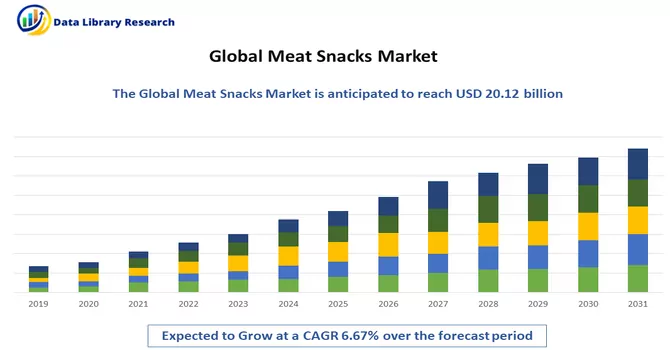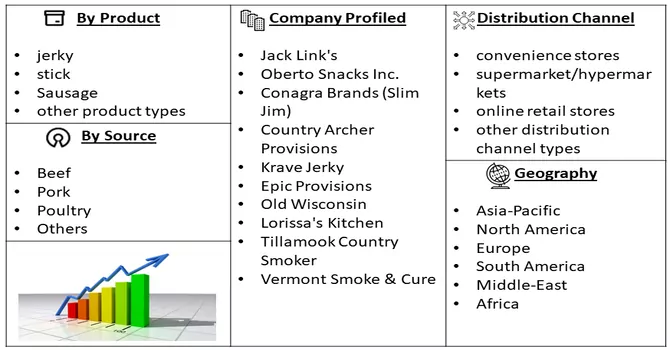The Meat Snacks Market size is estimated at USD 20.12 billion in 2023 and is expected to register a CAGR of 6.67%, during the forecast period, 2024-2031.

Get Complete Analysis Of The Report - Download Free Sample PDF
The meat snack market constitutes a sector within the food industry specializing in the production and sale of snacks primarily derived from meat or meat-based ingredients. These snacks undergo processing and packaging to offer convenient consumption and are presented in diverse forms like jerky, sticks, bites, and bars. This market caters to a broad spectrum of products designed to meet various tastes, dietary preferences, and nutritional requirements. A key driving force behind the growth of the meat snack market is the escalating consumer inclination towards protein-rich snacks as an integral part of a well-balanced diet and an active lifestyle.
Meat snacks serve as a practical and portable source of protein, gaining popularity among individuals seeking quick, satisfying, and nutritious snack options. The surge in health consciousness is another pivotal factor influencing the meat snack market. There is an increasing awareness of the health advantages associated with protein consumption, coupled with apprehensions regarding sugar and carbohydrate intake. Consequently, consumers are drawn towards snacks perceived as healthier alternatives to traditional options. Meat snacks, particularly those promoted as low in fat, sugar-free, and minimally processed, are capturing the attention of health-conscious individuals searching for better-for-you snack choices. This trend reflects a broader shift in consumer preferences towards snacks that align with their wellness goals and contribute to an overall healthy lifestyle.
The evolving consumer preference for healthier snack choices has sparked a surge in the demand for meat snacks perceived as nutritious and wholesome. This shift in consumer behavior has prompted manufacturers to innovate, focusing on developing products that boast clean labels, reduced sodium content, lower fat levels, and minimal processing. Moreover, there is a discernible interest in meat snacks crafted from grass-fed, antibiotic-free, and hormone-free meats, aligning with the preferences of health-conscious individuals. While meat snacks conventionally center around animal proteins, there is a notable uptick in the request for plant-based alternatives, particularly from vegetarian, vegan, and flexitarian consumers. To meet this growing demand, manufacturers are introducing plant-based options such as meat-free jerky and snack bars, utilizing plant-derived proteins like soy, pea, seitan, and mushrooms. These plant-based meat snacks aim to provide a texture and flavor reminiscent of traditional meat snacks, catering to the dietary choices of plant-based consumers and addressing ethical considerations. This trend reflects a dynamic landscape in the meat snack market, where the industry is adapting to diverse consumer needs and preferences. The expansion into plant-based alternatives not only broadens the market appeal but also demonstrates a commitment to offering snack options that resonate with an increasingly health-conscious and ethically minded consumer base.
Market Segmentation: The Global Meat Snacks Market by Application and is segmented by product type (jerky, stick, sausage, and other product types), by distribution channel (convenience stores, supermarket/hypermarkets, online retail stores, and other distribution channel types), and by geography (North America, Europe, Asia-Pacific, South America, and Middle East and Africa). The market size and forecasts are provided in terms of value (USD million) for the above segments.

For Detailed Market Segmentation - Download Free Sample PDF
Market Drivers:
Increasing Demand for Protein-rich Snacks
As consumer awareness about health and the importance of protein in their diets continues to rise, there is an evident and growing market demand for snacks that are rich in this essential nutrient. This shift in consumer preferences has propelled meat snacks into the spotlight, serving as a convenient and portable solution that has gained widespread popularity among individuals seeking snacks that are not only satisfying but also nutritious and suitable for on-the-go consumption. The increasing demand for protein-rich snacks is particularly driven by various consumer segments, including fitness enthusiasts, athletes, and individuals committed to maintaining a balanced diet and an active lifestyle. As these groups prioritize protein intake as a crucial aspect of their nutritional regimen, meat snacks have become a favored choice due to their accessibility and ease of consumption. This broader trend signifies a fundamental change in the way consumers approach their snacking habits, placing a heightened emphasis on the nutritional content of the snacks they choose. Meat snacks, in this context, have become more than just a convenient option; they represent a deliberate choice made by individuals seeking not only satisfaction and convenience but also a means to align their snacking choices with their health and wellness goals, particularly in terms of achieving adequate protein intake.
Rising Snacking Occasions
The evolving landscape of eating habits, coupled with the pace of contemporary lifestyles, has spurred a rising demand for meat snacks. This surge is notably attributed to shifts in consumer behavior, where the prevalence of snacking occasions, busy schedules, and on-the-go lifestyles intersect. As individuals increasingly embrace on-the-go eating, engage in desk-side snacking, and adopt grazing behaviors, there is a corresponding inclination towards snacks that offer both convenience and portion control. In the midst of these changes, consumers are actively seeking easily accessible, ready-to-eat options that align with their fast-paced lives. Meat snacks emerge as a solution to this demand, serving as convenient, grab-and-go choices that cater to the need for sustenance and energy between regular meals. Their popularity stems from the ability to meet the requirements of modern snacking patterns, providing a satisfying and portable source of nutrition that complements busy schedules. This trend underscores the adaptation of the food industry to accommodate the evolving ways in which individuals integrate snacks into their daily routines, reflecting a broader shift towards convenient and on-the-go snack solutions.
Market Restraints:
Health Concerns and Competition from Alternative Snacks
Despite attempts to introduce healthier alternatives, certain consumers still harbor reservations about meat snacks, citing apprehensions regarding their nutritional composition. Concerns related to elevated sodium levels, the inclusion of preservatives, and higher saturated fat content in some meat snacks may dissuade health-conscious individuals from embracing these products, potentially imposing limitations on market growth. The meat snack sector encounters competition from a broad spectrum of alternative snack choices, ranging from plant-based snacks to nuts, seeds, and protein bars. As consumer preferences undergo diversification, the prevalence of non-meat alternatives poses a challenge to the traditional meat snack market. This is particularly evident among vegetarian, vegan, and flexitarian consumers, who may opt for plant-based options that align more closely with their dietary choices and ethical considerations. In navigating this competitive landscape, the meat snack market must address concerns related to nutritional aspects while also embracing innovation to meet the evolving demands of a diverse consumer base. Adapting to changing preferences and emphasizing transparency in ingredient sourcing and processing methods could be crucial in overcoming barriers and sustaining market relevance.
The global supply chain faced significant disruptions during the pandemic, impacting the availability of crucial components like raw materials, ingredients, and packaging materials for meat snack manufacturers. Stringent lockdown measures, transportation constraints, and labor shortages caused notable interruptions in production and distribution networks. Consequently, this led to delays in the manufacturing, procurement, and delivery of meat snacks to the market. The pandemic-induced changes in consumer behavior and preferences further added complexity to the meat snack industry. With an increased amount of time spent at home, consumers exhibited a heightened interest in shelf-stable and pantry-friendly foods, prompting a notable upswing in demand for snacks offering convenience, portability, and extended shelf life – including meat snacks. However, the pandemic-driven shift in health-conscious consumer preferences also played a role. There emerged a growing interest in healthier snack options and foods believed to boost immunity. This dual dynamic impacted the demand for specific types of meat snacks, as consumers sought a balance between the comfort and convenience of meat snacks and their desire for nutritious, immune-boosting alternatives. The challenges and adaptations faced by the meat snack industry during the pandemic underscore the importance of resilience and flexibility in responding to evolving consumer needs and unpredictable external factors.
Segmentation Analysis:
Convenience stores Segment is Expected to Significant Growth Over the Forecast Period
Convenience stores are renowned for their convenience and strategic accessibility, strategically positioned in high-traffic zones such as urban centers, residential neighborhoods, office buildings, transportation hubs, and highway exits. This deliberate placement ensures easy access for consumers, contributing to the popularity of these establishments. Their extended operating hours, frequently spanning 24/7, cater specifically to the demands of modern, fast-paced lifestyles, providing consumers with unparalleled flexibility in shopping at any hour of the day or night. The deliberate location of convenience stores in areas with significant footfall or commuter traffic underscores their commitment to meeting the immediate needs of consumers. Whether individuals are in bustling city centers, residential areas, or navigating through highways, the ubiquity of convenience stores allows them to serve as go-to destinations for quick and accessible shopping. Moreover, the around-the-clock availability aligns seamlessly with the unpredictable and varying schedules of consumers, offering a level of convenience that goes beyond traditional retail hours. This adaptability to diverse schedules and locations solidifies the status of convenience stores as reliable and indispensable components of contemporary consumer lifestyles.
Online retail stores Segment is Expected to Significant Growth Over the Forecast Period
Online retail stores provide an extensive array of products spanning diverse categories, encompassing groceries, household essentials, snacks, beverages, personal care items, and beyond. This expansive product selection empowers consumers to discover precisely what they need without encountering the spatial constraints commonly associated with physical stores. The virtual retail landscape facilitates an unparalleled variety of choices, allowing customers to explore an extensive range of offerings that may not be feasible within the confined space of brick-and-mortar establishments. Unlike traditional stores constrained by physical shelf space, online retailers can curate a vast and diverse inventory, accommodating the diverse preferences and needs of consumers. This abundance of options not only enhances the overall shopping experience but also caters to individual preferences, dietary requirements, and lifestyle choices. Consumers benefit from the convenience of browsing through an extensive virtual marketplace, finding a myriad of products with the ease of a few clicks. The online retail model, with its expansive product assortment, thus revolutionizes the way consumers access and acquire a wide array of goods, transcending the limitations of traditional retail spaces.
North America Region is Expected to Significant Growth Over the Forecast Period
Convenience stores in North America present a varied selection of products, encompassing groceries, snacks, confectionery, beverages, tobacco products, lottery tickets, and personal care items. This carefully curated assortment is designed to address the immediate requirements and preferences of consumers looking for swift and effortless purchases. The diversity within the product range showcases the adaptability of North American convenience stores to cater to a wide spectrum of consumer needs. From everyday essentials like groceries to on-the-go snacks and personal care items, these stores aim to create a one-stop destination for quick and convenient shopping experiences. The inclusion of tobacco products, lottery tickets, and other convenience-oriented items reflects an understanding of the diverse preferences and demands of consumers in different moments and contexts. Thus, the strategic product assortment within North American convenience stores reflects a commitment to providing a seamless and efficient shopping experience. By offering a broad spectrum of products, these stores become hubs that cater to the varied and dynamic needs of consumers, ensuring accessibility and convenience in their day-to-day lives.

Get Complete Analysis Of The Report - Download Free Sample PDF
The analyzed market exhibits a high degree of fragmentation, primarily attributable to the presence of numerous players operating on both a global and regional scale. The competitive landscape is characterized by a diverse array of companies, each contributing to the overall market dynamics. This fragmentation arises from the existence of specialized solution providers, established industry players, and emerging entrants, all vying for market share. The diversity in market participants is underscored by the adoption of various strategies aimed at expanding the company presence. On a global scale, companies within the studied market are strategically positioning themselves through aggressive expansion initiatives. This often involves entering new geographical regions, targeting untapped markets, and establishing a robust global footprint. The pursuit of global expansion is driven by the recognition of diverse market opportunities and the desire to capitalize on emerging trends and demands across different regions. Simultaneously, at the regional level, companies are tailoring their approaches to align with local market dynamics. Regional players are leveraging their understanding of specific market nuances, regulatory environments, and consumer preferences to gain a competitive edge. This regional focus allows companies to cater to the unique needs of local clientele, fostering stronger market penetration. To navigate the complexities of the fragmented market, companies are implementing a range of strategies. These strategies include investments in research and development to stay at the forefront of technological advancements, mergers and acquisitions to consolidate market share, strategic partnerships for synergies, and innovation to differentiate products and services. The adoption of such multifaceted strategies reflects the competitive nature of the market, with participants continually seeking avenues for growth and sustainability. In essence, the high fragmentation in the studied market not only signifies the diversity of players but also underscores the dynamism and competitiveness that drive ongoing strategic maneuvers. As companies explore various avenues for expansion, the market continues to evolve, presenting both challenges and opportunities for industry stakeholders. Some of the market players working in this segment are:
Recent Developments:
1) In October 2023, Country Archer Provisions, a meat snack brand, introduced two innovative products to their lineup – the Rosemary Turkey Mini Sticks and Original Beef Jerky Snack Packs. These portioned protein snacks are tailored for health-conscious consumers, emphasizing clean-label ingredients. The Rosemary Turkey Mini Sticks boast a unique blend of herbs and spices, including rosemary, basil, thyme, garlic, and onion, while the Original Beef Jerky Snack Packs are crafted from grass-fed beef and seasoned with garlic and onion powder. This expansion in their product range reflects the brand's commitment to providing nutritious and flavorful options to its customer base.
2) In September 2023, Volpi Foods, a U.S.-based company, bolstered its presence in the meat snacks category by introducing a new line of Salami Stix. Emphasizing quality and natural ingredients, the company offers these products in 2-oz packages with a choice of two flavors – Spicy and Original. This expansion underscores Volpi Foods' dedication to delivering high-quality and flavorful options to consumers within the meat snacks market.
3) In April 2023 saw the entry of Doki Foods, a startup based in New Delhi, into the snack market with the launch of chicken chips and buffalo jerky. The company takes a creative approach by offering these products in enticing flavors such as Korean Gochujang, Tokyo Teriyaki, and Telicherry pepper. Doki Foods' introduction of these unique and culturally-inspired meat snacks reflects the brand's commitment to providing diverse and flavorful choices in the Indian market.
Q1. What was the Meat Snacks Market size in 2023?
As per Data Library Research the Meat Snacks Market size is estimated at USD 20.12 billion in 2023.
Q2. What is the Growth Rate of the Meat Snacks Market?
Meat Snacks Market is expected to register a CAGR of 6.67%, during the forecast period.
Q3. What are the factors driving the Meat Snacks Market?
Key factors that are driving the growth include the Increasing Demand for Protein-rich Snacks and Rising Snacking Occasions.
Q4. What are the factors on which the Meat Snacks Market research is based on?
By Application, By Product Type , By Distribution Channel and Geography are the factors on which the Meat Snacks Market research is based.
Data Library Research are conducted by industry experts who offer insight on industry structure, market segmentations technology assessment and competitive landscape (CL), and penetration, as well as on emerging trends. Their analysis is based on primary interviews (~ 80%) and secondary research (~ 20%) as well as years of professional expertise in their respective industries. Adding to this, by analysing historical trends and current market positions, our analysts predict where the market will be headed for the next five years. Furthermore, the varying trends of segment & categories geographically presented are also studied and the estimated based on the primary & secondary research.
In this particular report from the supply side Data Library Research has conducted primary surveys (interviews) with the key level executives (VP, CEO’s, Marketing Director, Business Development Manager and SOFT) of the companies that active & prominent as well as the midsized organization
FIGURE 1: DLR RESEARH PROCESS

Extensive primary research was conducted to gain a deeper insight of the market and industry performance. The analysis is based on both primary and secondary research as well as years of professional expertise in the respective industries.
In addition to analysing current and historical trends, our analysts predict where the market is headed over the next five years.
It varies by segment for these categories geographically presented in the list of market tables. Speaking about this particular report we have conducted primary surveys (interviews) with the key level executives (VP, CEO’s, Marketing Director, Business Development Manager and many more) of the major players active in the market.
Secondary ResearchSecondary research was mainly used to collect and identify information useful for the extensive, technical, market-oriented, and Friend’s study of the Global Extra Neutral Alcohol. It was also used to obtain key information about major players, market classification and segmentation according to the industry trends, geographical markets, and developments related to the market and technology perspectives. For this study, analysts have gathered information from various credible sources, such as annual reports, sec filings, journals, white papers, SOFT presentations, and company web sites.
Market Size EstimationBoth, top-down and bottom-up approaches were used to estimate and validate the size of the Global market and to estimate the size of various other dependent submarkets in the overall Extra Neutral Alcohol. The key players in the market were identified through secondary research and their market contributions in the respective geographies were determined through primary and secondary research.
Forecast Model
